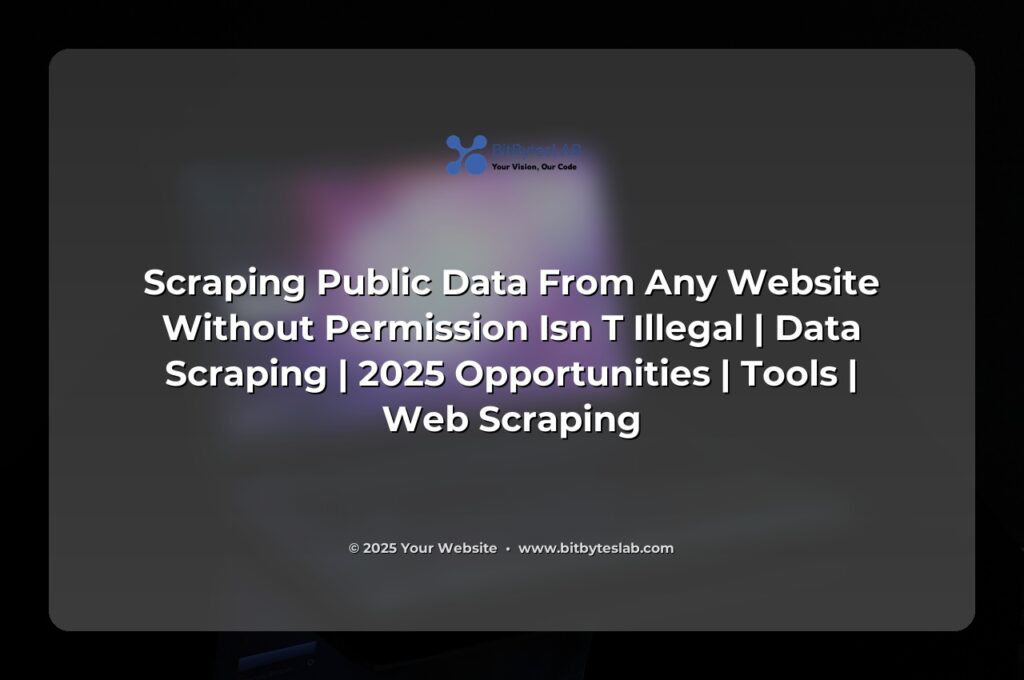Scraping Public Data From Any Website Without Permission Isn’t Illegal: What You Need to Know in 2025
When I first started in the data world, the headline “Scraping is illegal” was a common fear that hovered over every project. I’d read about lawsuits, IP bans, and the murky gray area of “public data.” Over the years, I’ve seen the rules evolve, and I’ve learned that the reality is far less binary than the headline suggests. It’s a matter of how you do it, not whether you do it.
In this post, I’ll share the real mechanics behind responsible public data extraction, the legal grey zones you’ve probably encountered, and the 2025 opportunities that make the skill not just useful but essential for modern businesses. Grab a coffee, and let’s dive in.
### The Problem: “It’s Public, So It’s Fair Game?”
Many entrepreneurs and analysts assume that if data is visible in a browser, it can be copied freely. That assumption overlooks three critical layers:
- Legal safeguards like Terms of Service and robots.txt that may explicitly forbid automated access.
- Privacy regulations (GDPR, CCPA) that impose data minimization and consent obligations even on public data.
- Reputational risk—companies that scrape aggressively can face backlash from both users and partners.
Because the web is a shared space, the responsibility to scrape ethically falls on the scraper, not the target site. In practice, that means respecting polite crawling rules, throttling requests, and keeping a clear record of what was accessed and why.
### Core Concepts & Methodologies
- Public vs. Private Data: Open product pages are easy, but you still need to consider terms and licensing.
- Robots.txt & Crawl‑Delay: A simple text file that tells crawlers where to stay away and how fast to move.
- Rate Limiting & Throttling: Mimic human behavior to avoid detection.
- User‑Agent & Headers: Identify your scraper responsibly.
- Session Management: Handle cookies and CSRF tokens for sites that rely on them.
- Legal & Ethical Dimensions: Copyright, privacy, GDPR, and anti‑scraping laws.
These fundamentals form a scaffold that any scraping strategy should respect. They’re the same building blocks I use when I set up a new extraction task, whether it’s pulling price data from an e‑commerce catalog or harvesting sentiment from a news site.
💾 There are only 10 types of people: those who understand binary and those who don’t 🔢

After laying out the high‑level concepts, it’s time to look at practical strategies that can turn these ideas into working pipelines.
### Expert Strategies & Approaches
- Intent‑Based Crawling: Define a clear data model before you write a single line of code. This reduces wasted traffic and keeps the scraper focused.
- Progressive Concurrency: Start with a conservative rate, then gradually increase while monitoring for throttling signals.
- Graceful Degradation: If a page fails, fall back to a simpler extraction method or a cached version.
- Automated Regression Tests: Run a small suite against known pages to catch selector breakage early.
- Transparent Logging: Log request headers, status codes, and parse failures in a structured format that feeds into monitoring dashboards.
These tactics help maintain stability, reduce runtime costs, and keep your operation within the legal boundaries set by ToS and privacy laws. In my experience, the biggest advantage of a well‑engineered scraper is its resilience: it adapts to site changes without breaking the entire pipeline.
### Industry Insights & Trends (2025)
- AI‑Driven Selector Generation: Modern NLP models can automatically generate CSS or XPath selectors from a handful of examples, cutting down the manual labor that used to cripple scaling.
- GraphQL & API Extraction: Many sites expose hidden GraphQL endpoints. Treating those as first‑class data sources can give you a cleaner, more reliable stream.
- Serverless & Edge Computing: Cloudflare Workers and AWS Lambda@Edge allow you to run scrapers right next to the data source, slashing latency and bandwidth costs.
- Privacy‑First Design: GDPR and CCPA have pushed organizations to build “privacy by design” into every data pipeline. Scrapers that automatically strip PII or anonymize data are becoming a competitive differentiator.
According to a 2024 study by the Data Innovation Institute, 62% of companies that adopted AI‑augmented scraping saw a 35% reduction in data acquisition time. That’s a real ROI you can’t ignore.
⚡ A SQL query goes into a bar, walks up to two tables and asks… ‘Can I join you?’ 🍺

### Business Applications & ROI
- E‑commerce: Real‑time price monitoring can trigger dynamic pricing algorithms that keep a shop ahead of the competition.
- Travel & Hospitality: Aggregating fare data from multiple OTA sites equips travel agencies with instant, market‑driven quotes.
- Finance: Pulling quarterly filings and news sentiment feeds feeds quantitative models that drive algorithmic trading.
- Marketing: Brand mention tracking across blogs and forums gives agencies an on‑hand pulse of campaign effectiveness.
Across industries, the key metric is not just the volume of data but the speed at which actionable insights surface. A well‑optimized scraper can turn hours of manual browsing into minutes of data‑driven decision‑making, translating to measurable revenue gains and cost savings.
### Common Challenges & Expert Solutions
- CAPTCHAs & Bot Detection: Rotate residential proxies, vary user‑agents, and employ CAPTCHA‑solving services only when absolutely necessary.
- Dynamic Content & Infinite Scroll: Inspect network traffic for XHR endpoints; if unavailable, use headless browsers with throttled scroll events.
- Rate Limiting / IP Bans: Implement exponential back‑off and a distributed token bucket per domain.
- Page Structure Changes: Adopt low‑coupling parsers, use data‑driven selectors, and trigger automated tests when a failure is detected.
- Legal Compliance: Anonymize personal data, keep retention schedules, and audit every scrape session.
My own teams have built “watchdog” dashboards that flag any sudden spikes in error rates or changes in the DOM structure. That proactive alerting has saved us from months of debugging and keeps our pipelines compliant.
### Future Trends & Opportunities
- Edge AI & Browser Automation: Future browsers may expose ML models that can interpret page intent, reducing the need for manual selectors.
- Data Marketplace Integration: Scrapers that publish cleaned datasets to platforms like OpenDataHub open new revenue streams.
- Compliance Automation: Tools that automatically scan scraped content for ToS violations or privacy flags will become industry standard.
- Hybrid Cloud Pipelines: Combining on‑prem data lakes with edge scrapers satisfies data‑residency requirements while harnessing scalability.
While the technical landscape is evolving rapidly, the foundational principle remains: **scraping is not a crime; misusing it is**. By staying informed, designing with ethics, and leveraging the right tools, you can tap into vast reservoirs of public data without stepping on legal or reputational landmines.
Ready to start or scale your data extraction effort? Let BitBytesLab guide you through the complexities, help you build compliant, high‑performance pipelines, and turn raw web data into strategic assets. 🚀💡

